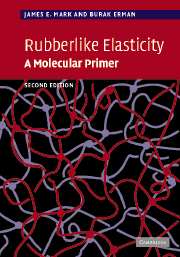Book contents
- Frontmatter
- Contents
- Preface to the first edition
- Preface to the second edition
- Part I Fundamentals
- 1 Introduction
- 2 Some rubberlike materials
- 3 The single molecule: theory and experiment
- 4 Preparation and structure of networks
- 5 Elementary statistical theory for idealized networks
- 6 Statistical theory for real networks
- 7 Elastic equations of state and force–deformation relations
- 8 Swelling of networks and volume phase transitions
- 9 Force as a function of temperature
- 10 Model elastomers
- Part II Additional topics
- Appendix A Relationships between ν, ξ and Mc
- Appendix B Relationships between 〈r2〉, 〈(Δr)2〉, 〈r2〉0, and ϕ
- Appendix C Equations of state for miscellaneous deformations from the constrained junction theory
- Appendix D Thermodynamics of the relationship of stress to temperature
- Problems
- Answers to problems
- Some publications describing laboratory/classroom experiments or demonstrations
- References
- Index
3 - The single molecule: theory and experiment
from Part I - Fundamentals
Published online by Cambridge University Press: 04 December 2009
- Frontmatter
- Contents
- Preface to the first edition
- Preface to the second edition
- Part I Fundamentals
- 1 Introduction
- 2 Some rubberlike materials
- 3 The single molecule: theory and experiment
- 4 Preparation and structure of networks
- 5 Elementary statistical theory for idealized networks
- 6 Statistical theory for real networks
- 7 Elastic equations of state and force–deformation relations
- 8 Swelling of networks and volume phase transitions
- 9 Force as a function of temperature
- 10 Model elastomers
- Part II Additional topics
- Appendix A Relationships between ν, ξ and Mc
- Appendix B Relationships between 〈r2〉, 〈(Δr)2〉, 〈r2〉0, and ϕ
- Appendix C Equations of state for miscellaneous deformations from the constrained junction theory
- Appendix D Thermodynamics of the relationship of stress to temperature
- Problems
- Answers to problems
- Some publications describing laboratory/classroom experiments or demonstrations
- References
- Index
Summary
Introduction
The single chain constitutes the basic building block of elastomers and understanding its structure and properties is necessary before going into the study of rubberlike elasticity. The original picture of a polymer chain as an isolated entity was by Guth and Mark (Guth and Mark, 1934) and Kuhn (Kuhn, 1934). According to this picture, the polymer chain consisted of freely jointed beads. Further developments elucidating the real nature of the single chain and its departure from the simple freely jointed model were made by several authors, notably by Volkenstein (Volkenstein, 1963) and Flory (Flory, 1953, 1969). The elastic properties such as the force–deformation relations of the single chain, to be used in constructing the elasticity theory, then followed through the use of thermodynamic relations. However, after the advance of experiments such as the atomic force microscope (AFM) and optical tweezers, direct experimental observation of the single chain behavior became possible (Chu, 1991; Granzier and Pollack, 2000; Janshoff et al., 2000; Hugel and Seitz, 2001; Strick et al., 2001; Zhang and Zhang, 2003; Hummer and Szabo, 2005; Barbara et al., 2005; Schuler, 2005). In this chapter, we will first outline the theoretical model of the single chain for a few simplified cases, and then relate this to experimental work on single chains.
Different models of the single chain, the end-to-end vector distribution and force–deformation relations
A simplified picture of the single chain is sketched in Figure 1.1, where the projection of the chain to the x-z coordinates is shown.
- Type
- Chapter
- Information
- Rubberlike ElasticityA Molecular Primer, pp. 25 - 38Publisher: Cambridge University PressPrint publication year: 2007



